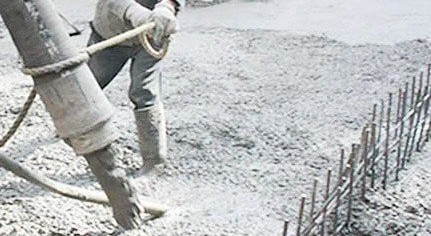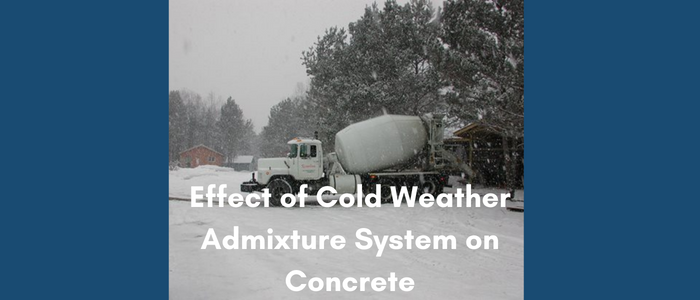This article represent the second part on the Effect of Cold Weather Admixture System on Concrete. This first part dealt with the effect of Cold Weather Admixture System (CWAS) on the fresh properties of concrete. In this part, we discuss the effect on the hardened concrete.

Before starting, I would like to mention that have multiple articles that discuss cold weather concreting. You may want to check for them before starting.
CONSTRUCTION PRACTICES FOR COLD WEATHER CONCRETING
COLD WEATHER CONCRETING: DEFINITION, ISSUES, AND PRECAUTIONS
Effect of CWAS on Concrete Hardened Properties
Effect of Cold Weather Admixture System on Concrete Compressive Strength
According to ACI 306R, concrete should reach 3.5 MPa before exposure to one single cycle of freezing and thawing and 24.5 MPa before exposure to multiple cycles.
As a result, it is crucial to consider how using CWAS affects concrete’s rate of gaining early and final design strengths while it is in cold weather.
I should note here that the late-age strength of concrete after 28 days will be the same as concrete without CWAS. In other word, CWAS may affect the early-age strength, but the end strength value will be the same.
In fact, some antifreeze admixtures like calcium nitrate and calcium nitrite act as accelerators and increase the rate of strength gain at the beginning.
Calcium nitrate specimens always give higher strength than plain concrete samples under the same curing conditions.
A previous study by Karagol showed that concrete containing 9% calcium nitrate cured at -5℃ could reach the same compressive strength as normal concrete cured under normal conditions.
Increasing the amount of calcium nitrate will increase the early concrete compressive strength.
Also, using urea gives higher strength than control samples under all curing conditions and temperatures.
In 1994, a study by Bennett reported that compressive strength of concrete incorporating 10% urea by wt. of cement with a water-to-cement ratio of 0.45 and cured at 20, -5, -10, -20℃ were 91, 88, 42, 0% of 28 days compressive strength of normally cured mixtures at 20℃, respectively.
This indicates the high efficiency of urea in terms of strength enhancement of concrete.
Regarding another type of Antifreeze (BM), it can produce concrete with compressive strength comparable to concrete cured under normal conditions of temperature and moisture.
In general, using antifreeze admixtures could maintain cement hydration and strength gain under low temperatures.
Antifreeze admixtures not only depress the freezing point of water but also accelerate the hydration process and strength gain of concrete.
However, care should be taken when dealing with CWAS because they may increase the strength but compromise durability. For example, sodium-based CWAS may provoke alkali aggregate reaction while Chloride-based admixtures may initiate corrosion of steel reinforcement and cause decomposition and expansion of hardened paste by forming calcium oxychloride
Another example is concrete incorporating high dosages (more than 6%) of calcium nitrate and/or calcium nitrite can be vulnerable to shrinkage cracking.
The following table show you different types of antifreeze admixtures and how they affect the compressive strength of concrete.
| Admixture | % by wt. of cement | Curing Temperature | reduction in strength compared to reference specimens cured for 28 days in room temperature (%) |
| CaCl2 | 7.2 | -15 | 50 |
| NaCl | 5.8 | -5 | 75 |
| NaNO2 | 6 | -5 | 69 |
| NaCl+CaCl2 | 7.5 | -20 | 80 |
| NaNO2+CaCl2 | 9 | -18 | 40 |
| Ca(NO2)2 + CO(NH2)2 | 9.4 | -5 | 80 |
| Ca(NO2)2 /(NO3)2 + CaCl2 +CO(NH2)2 | 11 | -20 | 38 |
| CO(NH2)2 | 9 | -5 | 54 |
| Ca(NO3)2 | 9 | -5 | 65 |
Effect of Cold Weather Admixture System on Concrete Tensile Strength
The tensile strength property is important with respect to freezing and thawing resistance.
Regarding the effect of CWAS on tensile strength of concrete, the antifreeze admixtures does not affect the tensile strength of concrete in most cases.
However, some antifreeze admixtures such as potash leads to considerable decrease in tensile strength of concrete under low temperatures.
Generally, the tensile strength of concrete decreased with the reduction in the curing temperature.
Effect of Cold Weather Admixture System on Concrete Bond Strength
Bond strength of concrete can be significantly affected by frost damage. Concrete may lose 70% of its bond strength due to early frost.
Using calcium nitrite and sodium nitrite may increase the bond strength of concrete.
Effect on Concrete Freeze-thaw damage
Using antifreeze admixtures can improve the freezing-thawing resistance of concrete by increasing the rate of strength gain at early age.
A previous study by Franke on the effect of using 4 and 8% of calcium nitrate only, air entraining admixture only and combination between them on concrete resistance of freezing-thawing cycles showed that using air entraining admixture is very important to produce concrete with high resistance to freezing and thawing, but it will affect negatively on concrete compressive strength.
Franke suggested that calcium nitrate, however, might assist in enhancing concrete compressive strength to counteract the weakening caused by the use of air entraining admixture. Additionally, calcium nitrate was said to aid in the distribution of air voids by increasing the number of micro voids and reducing the number of macro voids.
So, before using an antifreeze admixture, make sure how it will affect the performance of concrete.
